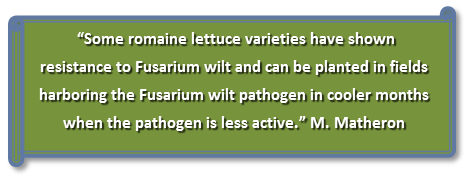
Since another lettuce growing season has begun in Arizona, we should review lettuce
diseases that can occur at this time. Diseases of most concern during the early
autumn are caused by soil-borne fungal pathogens and would include Fusarium wilt,
Sclerotinia drop, and bottom rot. Symptoms of Fusarium wilt, caused by Fusarium
oxysporum f. sp. lactucae, can appear on lettuce anytime after thinning. Effective
fungicides generally are not available to manage Fusarium wilt, although fumigation
with Vapam has suppressed disease severity in some field trials. This disease can
be effectively dealt with by not planting susceptible types of lettuce (virtually
all head lettuce varieties, for example) in ground known to contain the pathogen,
especially during September or October. Soil temperatures during these months favor
the growth of Fusarium oxysporum and the resulting development of the wilt disease.
Some romaine lettuce varieties have shown some resistance to Fusarium wilt and can
be planted in fields harboring the Fusarium wilt pathogen in cooler months when
the pathogen is less active. Sclerotinia drop and bottom rot usually do not become
apparent in fields until plants are at or past the rosette stage of development.
Successful management of Sclerotinia drop, caused mostly by Sclerotinia minor on
lettuce that will be harvested in November and December, as well as bottom rot caused
by Rhizoctonia solani, requires application of effective fungicides well before
the appearance of disease symptoms. Sclerotinia minor and Rhizoctonia solani exist
in soil as small resistant structures called sclerotia. Successful management of
the diseases caused by both pathogens is closely tied to preventing the germination
of these sclerotia; therefore, applications of fungicides are made to the soil,
where the sclerotia exist. Early application of fungicides, when plants are very
small, facilitates thorough coverage of the bed surface. As plants grow and cover
more of the bed surface, fungicide coverage of soil and disease control decline.
Click picture to listen to Mike's update

To contact Mike Matheron go to: matheron@ag.arizona.edu.



